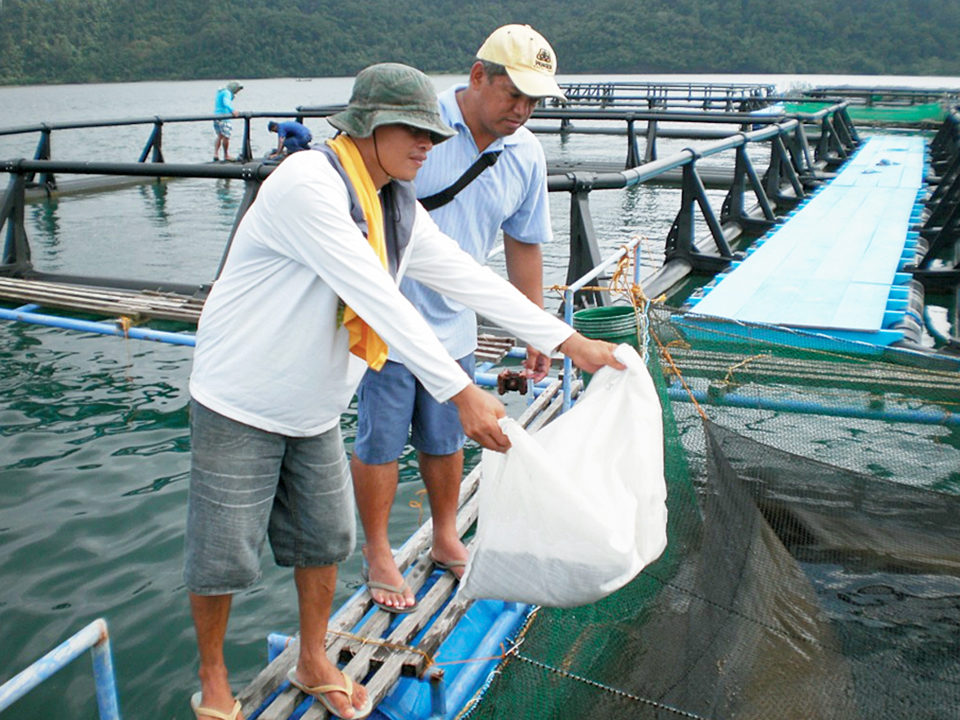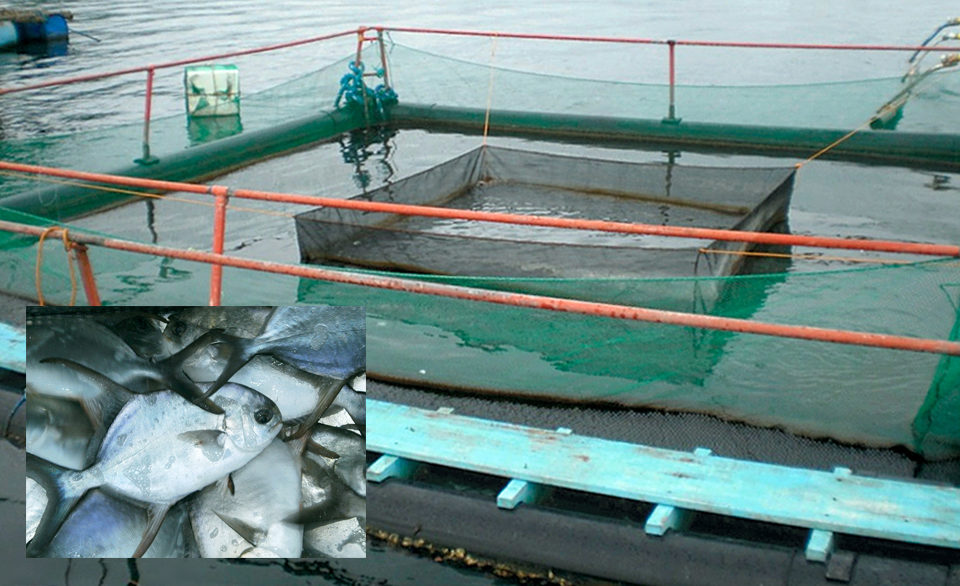Extruded floating feeds improved feed use limited pollution

Through the efforts of Dr. Michael Cremer, the American Soybean Association International Marketing (ASA-IM) program’s Soy-In-Aquaculture project in China developed a low-volume, high-density cage culture production methodology with the aim of maximizing farmer profits, improving productivity, reducing feed conversion and limiting environmental degradation.
The system maximizes cage production through the use of good site selection, proper cage positioning, limited cage volumes and maximized fish densities. It also incorporates proper feed management using high-quality, extruded floating feeds with feed enclosures that prevent floating feed from exiting the cages.
To illustrate the effectiveness of the ASA-IM cage production technology for high-value marine species in the Philippines, a demonstration project was recently begun.
Cage demonstration
The marine farm in the demonstration project normally used 5- x 5- x 5-meter or 125-cubic-meter floating cages that produced an average final harvest biomass of 8 kg per cubic meter. Six cages were attached to each other in a rectangular module that limited water exchange, particularly for cages in the middle of the module. Sinking pellet feeds were typically used with ad libitum feeding management.
Fish were fed using a “trickle method” with small amounts of feed broadcast into the cage over a long period of time. Feed managers fed the fish once in the morning and once in the afternoon, taking two to three hours per feeding session.
The ASA-IM project used three 125-cubic-meter floating cages that targeted a final biomass of 20 kg per cubic meter of pompano (Trachinotus blochii) using a 43 percent-protein, 12 percent-fat floating aquafeed. Fingerlings in cages A1 and A3 were stocked at a size of about 73 grams, while those stocked in cage A5 weighed 105 grams.
During the demonstration, only three of the six cages in the standard module configuration were used in a staggered formation, leaving the three cages in between vacant to allow water exchange to all four sides of each cage. Past research by ASA-IM also showed that the greatest production efficiencies were obtained by placing floating feed in the center of the cage within a feed enclosure reflecting 50 to 70 percent of the cage surface area to contain feed during feeding.
At the start of the demonstration, the farm manager and staff were hesitant about using extruded floating feeds. Their concerns regarding how to prevent the feed from exiting the cage when there were strong water currents were answered by the feed enclosure approach. In addition to the floating feed and feed enclosure, the ASA-IM 90 percent-satiation feeding technique was used to help limit waste.

Results
At the end of the demonstration, cage A5 had a total biomass of 2,754.6 kg or 22.04 kg per cubic meter with average body weight of 507 grams, feed-conversion ratio (FCR) of 1:2.49 and survival rate of 99.8 percent at 134 days of culture. Cages A1 and A3 yielded an average of 2,453.6 kg per cage or 19.6 kg per cubic meter of 464-g fish, FCR of 1:3.20 and 98.0 percent survival at 169 days of culture (Table 1).
Manalac, Performance of pompano stocked in cage, Table 1
| Cage A1 | Cage A3 | age A5 | |
|---|---|---|---|
| Initial average body weight (kg | 0.073 | 0.073 | 0.105 |
| Average body weight (kg) | 0.473 | 0.454 | 0.507 |
| Total biomass (kg) | 2,555 | 2,352 | 2,754 |
| Production (kg fish/m³) | 20.44 | 18.82 | 22.04 |
| Survival rate (%) | 99.4 | 96.0 | 99.9 |
| Feed-conversion ratio | 3.06 | 3.34 | 2.49 |
| Culture period (days) | 169 | 169 | 134 |
The demonstration was a learning experience for the farmer. Even with high feed conversion, the production showed great improvement compared to the previous year’s harvest. The farm now uses only extruded floating feed, and the cooperating feed mill now promotes the use of floating feeds to its fish cage customers.
Using extruded floating feeds improved feed use and helped in limiting environmental pollution. The satiation feed management increased savings due to lower FCRs and the decrease in labor required to grow fish faster than before.
(Editor’s Note: This article was originally published in the September/October 2010 print edition of the Global Aquaculture Advocate.)
Now that you've finished reading the article ...
… we hope you’ll consider supporting our mission to document the evolution of the global aquaculture industry and share our vast network of contributors’ expansive knowledge every week.
By becoming a Global Seafood Alliance member, you’re ensuring that all of the pre-competitive work we do through member benefits, resources and events can continue. Individual membership costs just $50 a year. GSA individual and corporate members receive complimentary access to a series of GOAL virtual events beginning in April. Join now.
Not a GSA member? Join us.
Authors
-
Levy Loreto L. Manalac
Technical Manager – Aquaculture
American Soybean Association International Marketing
Soy-In-Aquaculture Program
37 Bonuan Sabangan
Dagupan City, Pangasinan 2400 Philippines[109,111,99,46,111,111,104,97,121,64,48,48,48,50,55,49,55,121,118,101,108]
-
Lukas Manomaitis
Technical Director – Aquaculture
ASA-IM Soy-In-Aquaculture Program
Singapore
Tagged With
Related Posts

Aquafeeds
Evaluating dietary fish oil replacement in juvenile Florida pompano
Study evaluated production performance and tissue composition of juvenile Florida pompano fed diets containing fish oil or 25:75 blends of fish oil and various other lipid sources.

Health & Welfare
High-soy, fishmeal-free diets support Florida pompano growth
The authors have achieved good growth using a fishmeal-free diet for the carnivorous marine fish Florida pompano. In studies, they used pompano as a model marine species in a cost/benefit analysis of two extruded diets.

Aquafeeds
Replacing fishmeal with DFB in pompano diets
A study evaluated the inclusion of bacterial, dried fermented biomass as a replacement for fishmeal in four practical diets for Florida pompano juveniles. There were no significant differences in final weight, survival, FCR or thermal-unit growth coefficient.

Intelligence
Bahamas venture focuses on grouper, other high-value marine fish
A new venture under development in the Bahamas will capitalize on Tropic Seafood’s established logistics and infrastructure to diversify its operations from processing and selling wild fisheries products to include the culture of grouper and other marine fish.


